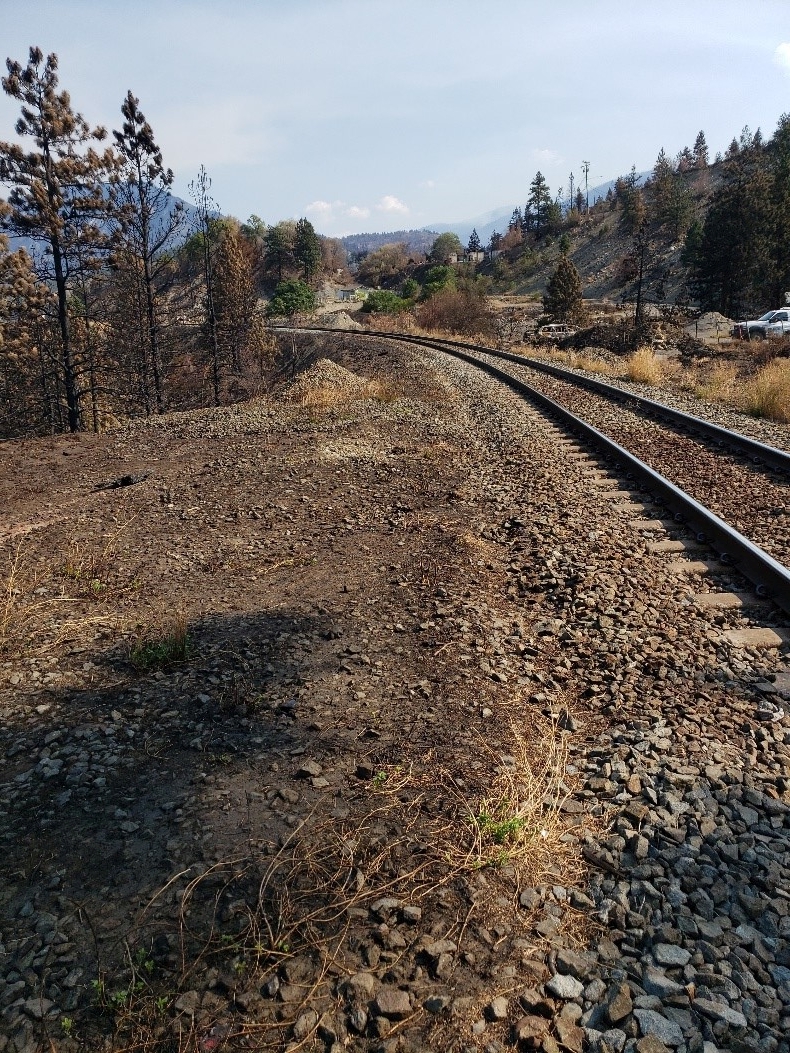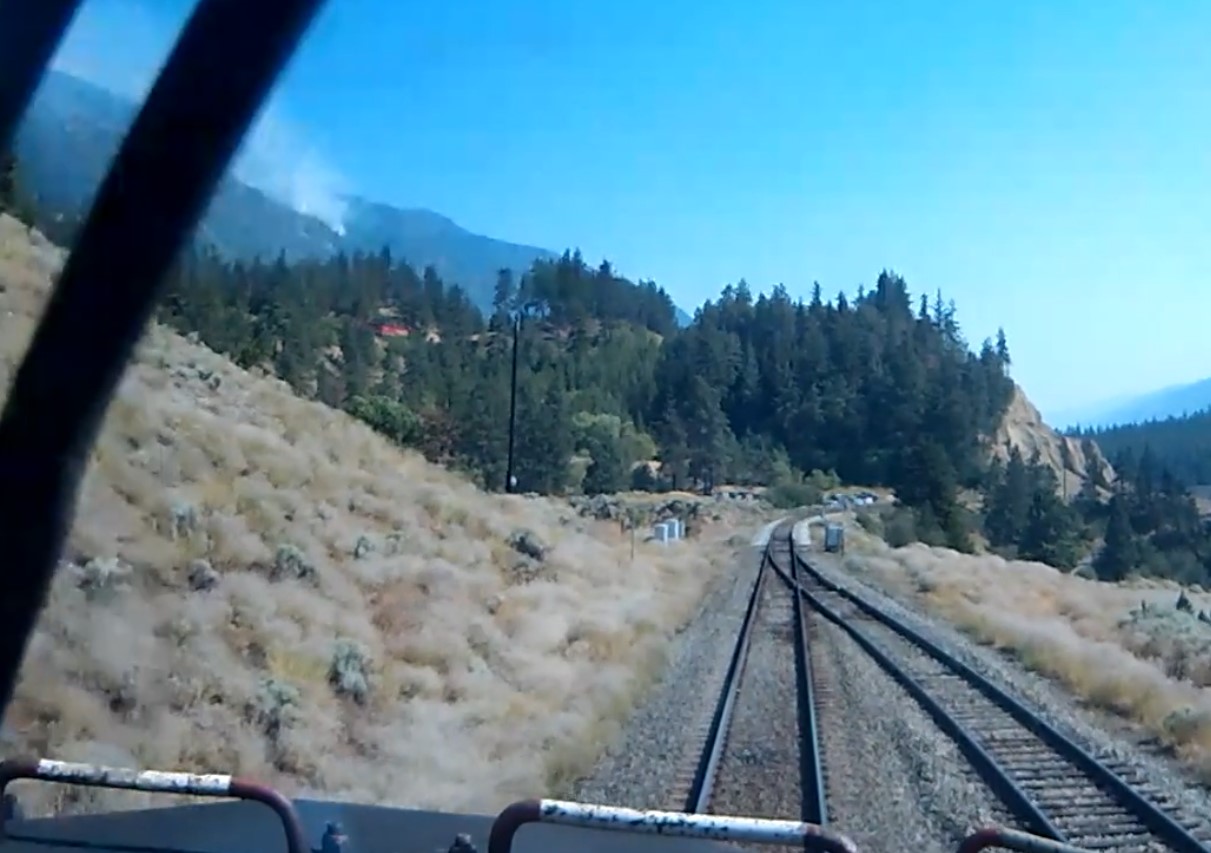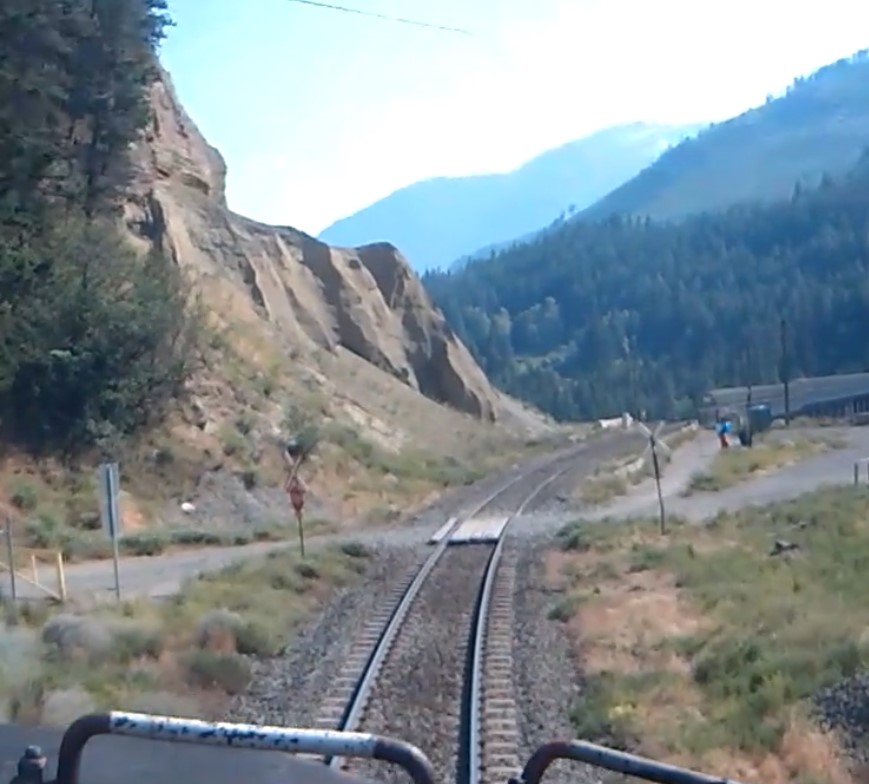Possible train activity-related fire
Vicinity of Mile 98.3, Canadian National Ashcroft Subdivision
Lytton, British Columbia (as reported by BC Wildfire Service)
The occurrence
On 30 June 2021, at approximately 1648 Pacific Daylight Time (PDT), a fire was reported near the Canadian National (CN) right-of-way in the vicinity of Mile 98.14 of the CN Ashcroft Subdivision, just west of the town of Lytton, British Columbia (BC). The fire grew rapidly due to the extreme hot and dry conditions combined with high velocity winds, and ultimately devastated the majority of the structures in the town’s downtown area.
Train C73152-29, a westbound loaded unit coal train (157 cars), powered by CP locomotives and operated by a CN Crew, was the last train to pass through Lytton on the CN Ashcroft Subdivision prior to the first report of fire. The train operated through the suspected area of the fire’s origin at about 1630, about 18 minutes prior to the reporting of the fire. It was travelling at 25 mph (40 km/h) with low to moderate throttle to maintain speed. CP 300-29 was the last train to pass through the Lytton area eastbound on the CP Thompson Subdivision prior to the 1st report of the fire. There was no occurrence reported to the TSB by either CN or CP and nor were they aware of any such occurrence when specifically asked by the TSB.
TSB involvement
Based on additional information received from the Royal Canadian Mounted Police (RCMP) and British Columbia Wildfire Service (BCWS), and in light of the presence of rolling stock in the immediate vicinity of the fire within minutes of the fire first being reported, the TSB had reasonable grounds to believe that there was a situation or condition that could induce an accident or incident (i.e. a fire caused by rolling stock).
The TSB deployed an investigator on 9 July 2021 to gather information, examine and photograph the area, and assess the circumstances to determine if the rolling stock that passed through Lytton could have caused or sustained a fire.
TSB assessment
The TSB took the following steps to assess the circumstances:
- TSB confirmed with CN and CP that no rail grinding activities or track work had taken place in the area that day or in the days before the 1st report of fire on 30 June 2021.
- TSB’s investigator inspected the train C73152-29 after it had been off-loaded and was secured in Burnaby, BC, looking for signs of hot bearings, burnt brake heads, built-up tread, and other potential fire-creating causes. No anomalies were noted. Transport Canada had also performed a safety inspection of the train earlier at the request of the RCMP and noted no anomalies.
- A TSB investigator met with a BCWS fire origin investigator in Lytton.
- Interviews were conducted with railway employees engaged in operating trains in the area or in maintenance activities. No anomalies were observed or reported.
Substance sample analysis
- The BCWS expressed interest in samples of a black, carbonaceous coal-like substance, gathered from a location on the west side of the track near Mile 98.14 of the CN Ashcroft Subdivision, as a possible source of ignition and conducted a laboratory analysis of the substance.
- The TSB also collected samples of the substance which were sent to TSB’s Engineering Laboratory (lab) for material analysis. Comparison samples gathered from a locomotive exhaust stack and a rail grinder vehicle were also collected and sent to the TSB lab for analysis. The spectral results revealed that the 3 analyzed samples have little in common.
Locomotives recorders
- The TSB requested the lead and mid-train forward-facing videos (FFV) from C73152-29 and FFV from CP 300-29 from both CN and CP.
- TSB investigators examined the data from the last 2 hot box detectors encountered by C73152-29 located at Seddall, Mile 82.8 and Lasha, Mile 96.5. There were no anomalies noted.
- TSB investigators downloaded and reviewed data from the train C73152-29 locomotive event recorder from the lead locomotive and the tail end remote locomotive. There were no anomalies noted with the operation of the train through Lytton
Load testing
- TSB’s investigator attended load testing, which simulates the operation of the locomotive under load, of the 3 locomotives from train C73152-29.
During this test, the diesel engine is cycled up to maximum operating RPM while the locomotive is stationary and output horsepower is measured. No sparking was noted during the load testing of either of the 3 locomotives. Exhaust stacks of the locomotives were also inspected and found to be clear of carbon build up.
Other investigation activities
- The TSB attempted to determine if satellite images of the Lytton area were available for the time frame encompassing the passage of the last train through the area at about 1630 PDT and the time of the 1st report of fire in Lytton at 1648 PDT. No images were available.
Conclusion
A fire is reportable to the TSB as a transportation occurrence if it is known that the operation of railway rolling stock causes or sustains a fire. There has been no report of such an occurrence made to the TSB by either railway that operates through the area.
The TSB has conducted significant investigative work to determine if there was a definitive connection between railway operations through Lytton, BC and the fire that destroyed the town on 30 June 2021.
The TSB investigation has not identified any link between railway operations and the fire. Further effort, beyond a Class 5 TSB investigation, is not warranted unless new information establishes that a TSB reportable event (i.e. an accident or incident involving rolling stock) occurred.
Media materials
News releases
TSB investigation of Lytton fire finds no evidence of railway operations’ involvement
Read the news release
Media advisory
The TSB will share the result of its investigation of a possible relation between train activities and the June 2021 fire in Lytton, BC
Read the media advisory
Deployment notice
TSB deploys team to the site of potential train fire in Lytton, British Columbia
Richmond, British Columbia, 9 July 2021 — The Transportation Safety Board of Canada (TSB) is deploying a team of investigators following a fire potentially involving a freight train in Lytton, British Columbia. The TSB will gather information and assess the occurrence.
Backgrounder
Common causes of fire in Canada's rail transportation sector
Read the backgrounder
Class of investigation
This is a class 5 investigation. Class 5 investigations are limited to collecting data, which are then stored in the modal database. If TSB investigators deployed to the occurrence site, a short description of the occurrence is posted to the TSB website once the investigation has been completed. These investigations are generally completed within 90 days. For more information, see the Policy on Occurrence Classification.
TSB investigation process
There are 3 phases to a TSB investigation
- Field phase: a team of investigators examines the occurrence site and wreckage, interviews witnesses and collects pertinent information.
- Examination and analysis phase: the TSB reviews pertinent records, tests components of the wreckage in the lab, determines the sequence of events and identifies safety deficiencies. When safety deficiencies are suspected or confirmed, the TSB advises the appropriate authority without waiting until publication of the final report.
- Report phase: a confidential draft report is approved by the Board and sent to persons and corporations who are directly concerned by the report. They then have the opportunity to dispute or correct information they believe to be incorrect. The Board considers all representations before approving the final report, which is subsequently released to the public.
For more information, see our Investigation process page.
The TSB is an independent agency that investigates air, marine, pipeline, and rail transportation occurrences. Its sole aim is the advancement of transportation safety. It is not the function of the Board to assign fault or determine civil or criminal liability.


